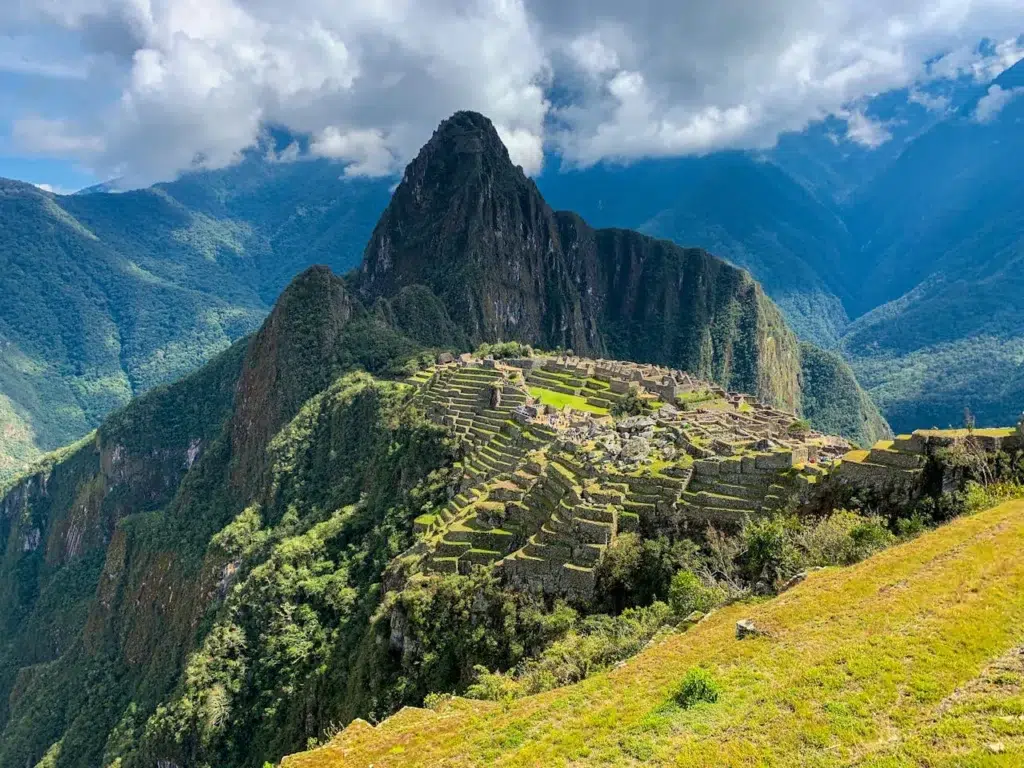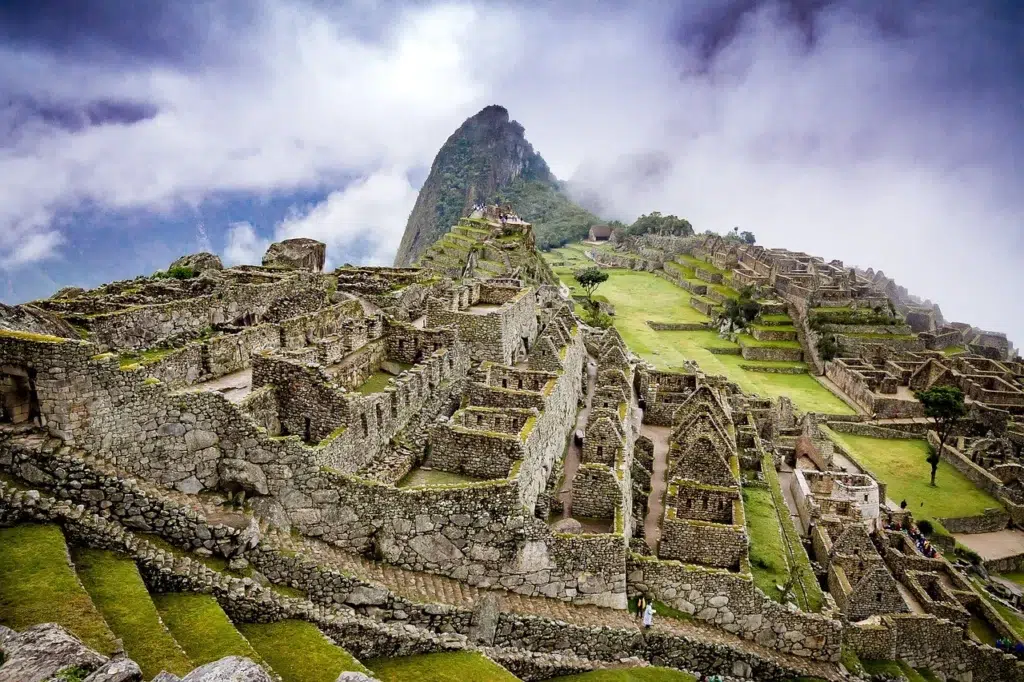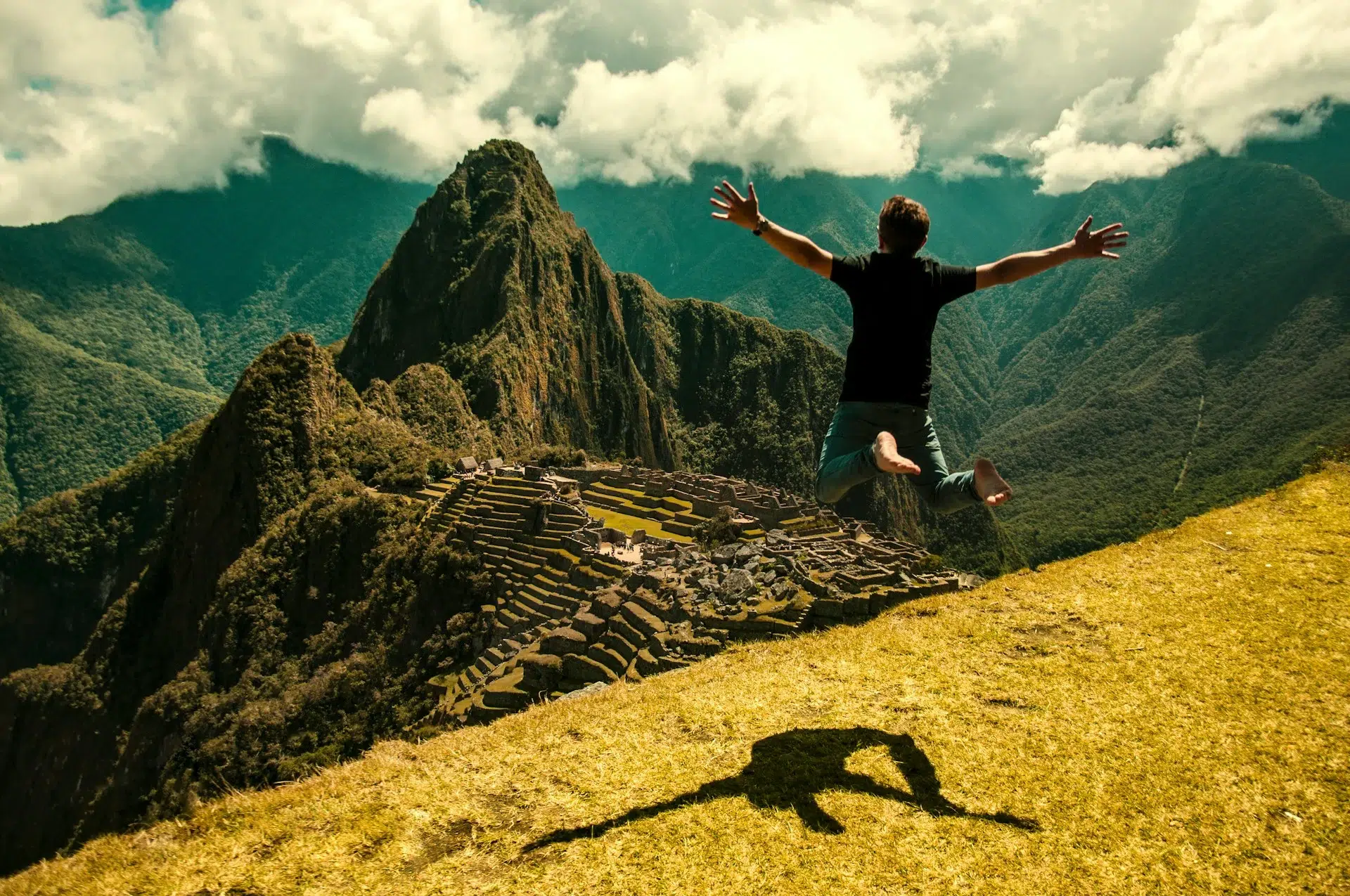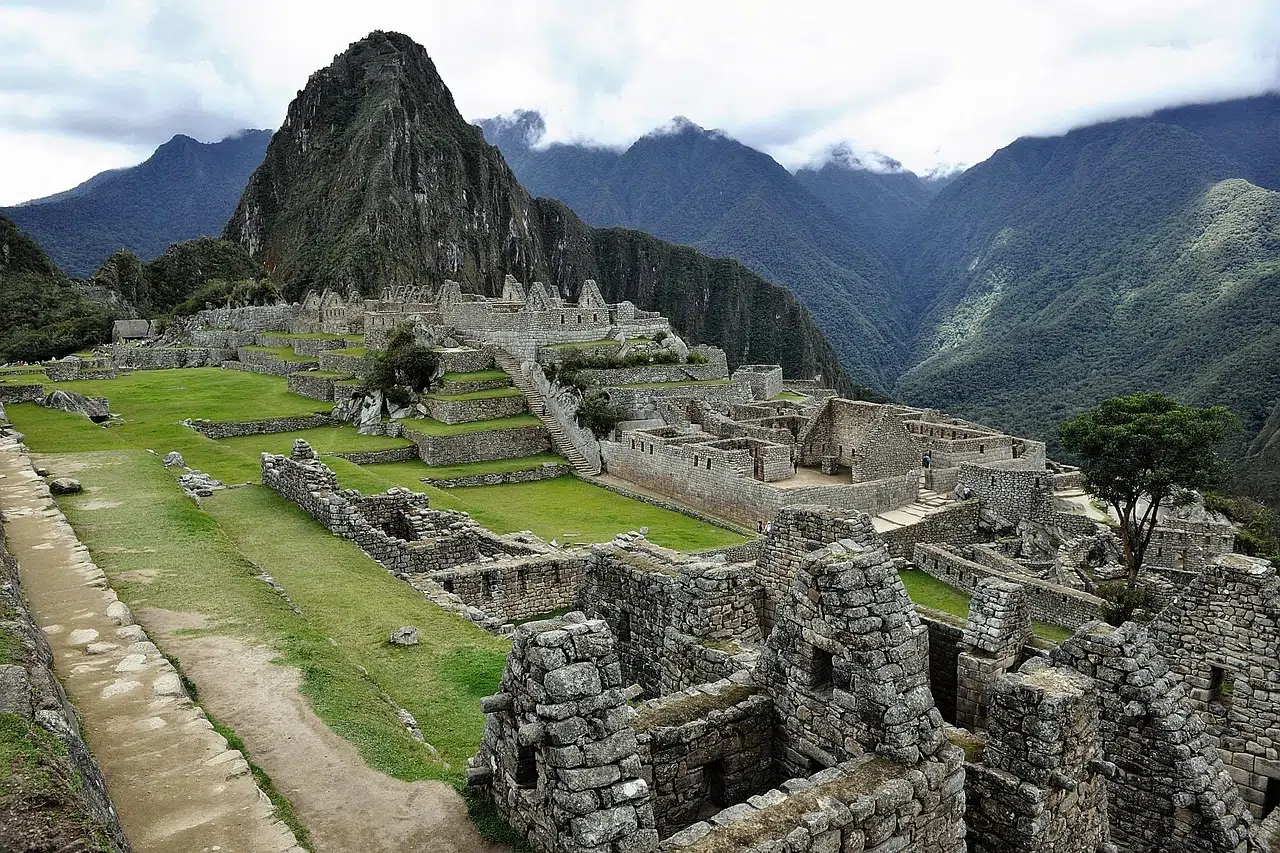Machu Picchu Peru, the legendary Lost City of the Incas, is one of the most awe-inspiring archaeological sites in the world. Nestled high in the Andes Mountains of Peru, this UNESCO World Heritage site and one of the New Seven Wonders of the World attracts millions of visitors each year.
This guide provides everything you need to know about Machu Picchu, from its fascinating history and breathtaking architecture to practical information on how to visit. Whether you are planning a trip or simply curious about this magnificent Incan citadel, this article offers a comprehensive and detailed overview.
Tours Machu Picchu
Why Visit Machu Picchu?
Machu Picchu, the lost city of the Incas, is one of the most breathtaking archaeological sites in the world. Nestled in the Peruvian Andes, this UNESCO World Heritage Site and one of the New Seven Wonders of the World attracts thousands of travelers yearly.
This guide will cover everything you need to know about visiting Machu Picchu in 2025, from historical insights to the best hiking routes, ticket information, weather, and travel tips. Whether you’re an adventure seeker or a history enthusiast, Machu Picchu offers a once-in-a-lifetime experience.
The History of Machu Picchu Peru
The Origins of Machu Picchu
Machu Picchu was built in the 15th century during the reign of Inca emperor Pachacuti. It is believed to have been a royal estate or a religious retreat for the Incan elite. The site remained hidden from the outside world for centuries, only to be rediscovered in 1911 by American historian Hiram Bingham.
Abandonment and Rediscovery
Unlike many other Incan sites, Machu Picchu was not discovered by the Spanish during their conquest of the Inca Empire. Historians speculate that it was abandoned in the late 16th century due to the collapse of the empire. The jungle gradually reclaimed the ruins, preserving them until Bingham brought them to global attention.

Architectural Marvels of Machu Picchu
Machu Picchu is a masterpiece of engineering and architecture. It is divided into two main areas: the agricultural sector and the urban sector.
The Agricultural Terraces
The site features a sophisticated system of terraces that prevented erosion and allowed for efficient farming in the steep Andean landscape. These terraces also helped to stabilize the mountain slopes, demonstrating the advanced knowledge of Incan engineers.
Key Structures
- The Intihuatana Stone – A ritual stone associated with astronomical observations, believed to have been used for ceremonial purposes.
- The Temple of the Sun – A semi-circular structure with fine stonework, thought to have been an important religious site.
- The Room of the Three Windows – A beautifully constructed building with three trapezoidal windows, possibly symbolizing key elements of Incan cosmology.
- The Main Plaza – A large open space used for ceremonies and gatherings.
- Huayna Picchu – The towering peak behind Machu Picchu, offering panoramic views of the ruins and surrounding mountains.
How to Get to Machu Picchu
Traveling to Aguas Calientes
Most visitors reach Machu Picchu via Aguas Calientes, a small town located at the base of the mountain. The most popular ways to get there include:
- Train from Cusco or Ollantaytambo – The most convenient and scenic route, taking approximately 1.5 to 3.5 hours.
- Hiking the Inca Trail – A multi-day trek through the Andes, offering stunning views and an immersive historical experience.
- Alternative Treks – The Salkantay Trek, Lares Trek, and Inca Jungle Trek are alternative routes that provide unique perspectives of the Peruvian landscape.
Reaching the Citadel
From Aguas Calientes, visitors can either hike up to Machu Picchu or take a 30-minute bus ride. It is recommended to arrive early in the morning to witness the sunrise over the ruins.
Best Time to Visit Machu Picchu
The best time to visit Machu Picchu depends on the weather and tourist crowds.
- Dry Season (May to October) – The best time for clear skies and stable weather. However, this is also the busiest season.
- Rainy Season (November to April) – Fewer tourists and greener landscapes, but trails can be muddy and cloud cover may obstruct views.
Machu Picchu Tickets and Regulations
Types of Tickets
Visitors must purchase tickets in advance, as daily entries are limited. Ticket options include:
- Machu Picchu General Entry – Allows access to the main site.
- Machu Picchu + Huayna Picchu – Includes a climb to the iconic peak for breathtaking views.
- Machu Picchu + Mountain – A more challenging hike with panoramic scenery.
- Machu Picchu + Huchuy Picchu – A shorter hike to a lesser-known viewpoint.
Booking in Advance
Due to high demand, tickets should be booked months in advance, especially for Huayna Picchu hikes. Reservations can be made through the official government website or authorized tour agencies.

Tips for Visiting Machu Picchu Peru
- Arrive Early – Visiting in the morning provides a quieter experience and beautiful lighting.
- Wear Comfortable Clothing – Layers are ideal due to varying temperatures.
- Bring Water and Snacks – Food is not sold within the site.
- Respect the Rules – Drones, tripods, and large backpacks are prohibited.
- Hire a Guide – Official guides offer valuable insights into the site’s history and significance.
Machu Picchu Weather
The weather in Machu Picchu is influenced by its location in the Andean cloud forest, meaning it experiences mild temperatures year-round but also high humidity and sudden weather changes. Understanding the climate will help you prepare properly for your visit.
1. Seasons in Machu Picchu Peru
Machu Picchu has two main seasons:
🌞 Dry Season (May – October):
✅ Best weather conditions – Sunny days, clear skies, and cooler nights.
✅ Ideal for hiking – Lower chances of rain, making trails like the Inka Trail safer.
✅ High tourist season – Expect crowds and higher prices for tours and accommodations.
🌧️ Rainy Season (November – April):
✅ Lush green landscapes – The vegetation is at its most vibrant.
✅ Fewer tourists – Less crowded ruins and better photo opportunities.
✅ Unpredictable rain showers – Sudden downpours can make trails muddy and slippery.
2. Month-by-Month Weather Overview
| Month | Temperature (°C/°F) | Rainfall | Tourist Activity |
| January | 12-26°C (54-79°F) | 🌧️🌧️🌧️ Very High | Low |
| February | 12-26°C (54-79°F) | 🌧️🌧️🌧️ Very High | Very Low (Inka Trail closed) |
| March | 12-25°C (54-77°F) | 🌧️🌧️ High | Moderate |
| April | 12-25°C (54-77°F) | 🌧️ Medium | High |
| May | 10-24°C (50-75°F) | ☀️ Low | High |
| June | 9-23°C (48-73°F) | ☀️ Very Low | Very High |
| July | 9-23°C (48-73°F) | ☀️ Very Low | Very High |
| August | 9-24°C (48-75°F) | ☀️ Very Low | High |
| September | 10-25°C (50-77°F) | 🌤️ Medium | High |
| October | 11-25°C (52-77°F) | 🌤️ Medium | Moderate |
| November | 12-26°C (54-79°F) | 🌧️ High | Moderate |
| December | 12-26°C (54-79°F) | 🌧️🌧️ High | Low |
Weather Tips for Visiting Machu Picchu
✅ Always bring a rain jacket – Even in the dry season, rain showers are possible.
✅ Dress in layers – Mornings can be chilly, but midday gets warm.
✅ Wear waterproof hiking shoes – Essential if you’re trekking in the rainy season.
✅ Use sun protection – High UV exposure even on cloudy days.

Machu Picchu Altitude: What You Need to Know 🏔️
Understanding Machu Picchus Elevation and Its Impact on Travelers
Machu Picchu sits at an altitude of 2,430 meters (7,970 feet) above sea level, significantly lower than Cusco (3,399 meters / 11,152 feet). While this elevation is not considered extreme, visitors should still be aware of altitude-related challenges, especially if arriving directly from a high-altitude location.
1. Altitude Comparison
| Location | Altitude (meters/feet) |
| Cusco | 3,399 m / 11,152 ft |
| Ollantaytambo | 2,792 m / 9,160 ft |
| Machu Picchu | 2,430 m / 7,970 ft |
| Aguas Calientes | 2,040 m / 6,693 ft |
2. Will You Experience Altitude Sickness?
Since Machu Picchu is lower than Cusco, most visitors feel relief from altitude symptoms upon descending from the city. However, if you hike the Inka Trail or Salkantay Trek, you may reach elevations over 4,200 meters (13,780 feet), where altitude sickness is more likely.
Symptoms of Altitude Sickness 🤕
- Headache
- Dizziness
- Shortness of breath
- Nausea
How to Prevent It ✅
- Acclimate in Cusco (1-2 days before hiking).
- Stay hydrated and avoid alcohol.
- Drink coca tea, a local remedy for altitude discomfort.
- Ascend gradually if trekking to Machu Picchu.

Machu Picchu Guided Tours vs. Self-Guided Visits: Which One is Right for You?
Visiting Machu Picchu is a once-in-a-lifetime experience, but one of the biggest decisions travelers face is whether to hire a guide or explore the ruins on their own. Both options have pros and cons, depending on your budget, interests, and travel style. Below, we’ll compare Machu Picchu guided tours vs. self-guided visits to help you decide which option is best for you.
1. Machu Picchu Guided Tours: What to Expect
Hiring a licensed tour guide is an excellent way to experience Machu Picchu, especially if you want to fully understand its history, architecture, and hidden details. Since 2017, Peruvian regulations require visitors to enter with a guide, though enforcement varies.
Pros of a Guided Tour ✅
✅ Deep Historical & Cultural Insights – Guides provide fascinating information about Inca civilization, astronomy, and architecture, enriching your experience.
✅ Efficient Itinerary – Guides plan the best route, helping you navigate the complex without missing key sites like the Sun Temple, Intihuatana Stone, and Royal Tomb.
✅ Better Storytelling – Hearing legends, facts, and hidden details makes the ruins come to life.
✅ Avoid Getting Lost – While Machu Picchu is well-signposted, a guide ensures you don’t miss important structures or viewpoints.
✅ Support Local Economy – Hiring a local, certified guide contributes to the community and helps preserve cultural heritage.
Cons of a Guided Tour ❌
❌ Higher Cost – Private or group tours range from $30 to $150 per person, depending on group size and service quality.
❌ Fixed Itinerary – Guides follow pre-planned routes, so you might not have as much time to explore at your own pace.
❌ Limited Personal Experience – If you prefer to explore freely, take extra photos, or sit and admire the view, a tour might feel rushed.
Machu Picchu Hiking Routes
Inca Trail (4 days, 3 nights)
- Most famous route, passing Inca ruins.
- Requires a permit (sold out months in advance).
Salkantay Trek (5 days, 4 nights)
- More scenic, passing glaciers and cloud forests.
- No permit needed.
Lares Trek (4 days, 3 nights)
- Cultural experience, visiting indigenous villages.
Inca Jungle Trek (4 days, 3 nights)
- Includes biking, rafting, and hiking.
Each trek offers a unique experience, depending on difficulty level and scenery preference.
Where to Stay Near Machu Picchu
There are three main places to stay:
- Cusco – Best for before & after visiting Machu Picchu.
- Ollantaytambo – Closer to the train station.
- Aguas Calientes – Right at the base of Machu Picchu.
Hotels range from budget hostels ($15/night) to luxury lodges ($500+/night).

Essential Travel Tips for Machu Picchu
- Pack light: Wear comfortable clothes, waterproof gear, and hiking boots.
- Altitude sickness: Acclimatize in Cusco for 2-3 days before hiking.
- Stay hydrated: Bring a refillable water bottle.
- Respect the rules: No tripods, drones, or large backpacks allowed.
Conclusion: Is Machu Picchu Worth Visiting?
Machu Picchu is a destination that captivates travelers with its mystery, beauty, and historical significance. Whether you hike the Inca Trail, take the train, or simply marvel at the site’s architectural wonders, visiting Machu Picchu is a once-in-a-lifetime experience.
Plan your trip carefully, respect the site’s cultural heritage, and immerse yourself in the magic of this ancient Incan city. With proper preparation, your visit to Machu Picchu will be unforgettable.
Absolutely! Whether you hike, take the train, or do a guided tour, Machu Picchu is a must-visit destination for history lovers, hikers, and adventure seekers.
By following this complete guide, you’ll be well-prepared for an unforgettable journey to one of the world’s most iconic landmarks. 🌿✨


